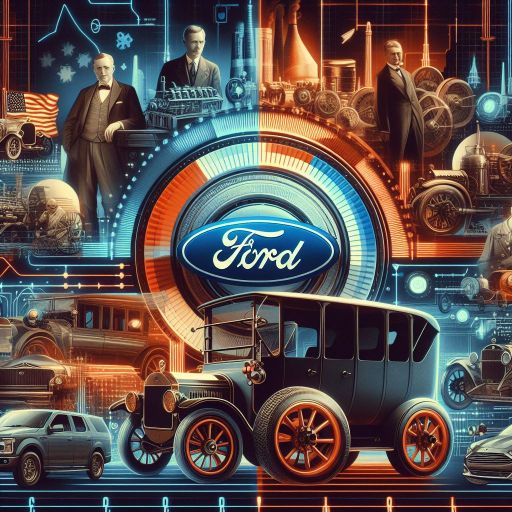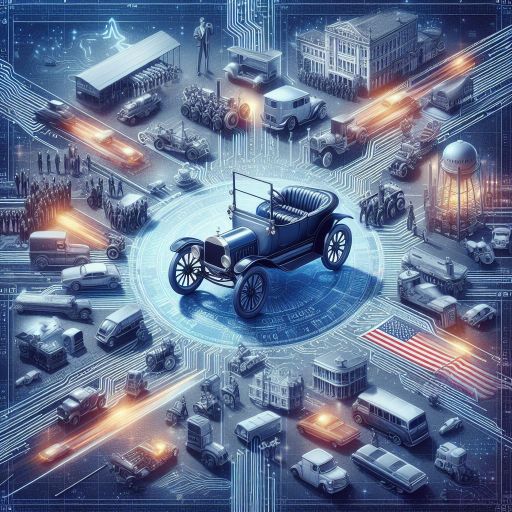Know All About the History of the Big 3 Automakers in the World
Over the years, General Motors, Stellantis (formerly Chrysler), and Ford epitomized the American car industry.
Their historical journey of adaptation to change and handling challenges amidst the changing market environment illustrates their historical significance as well as their current positioning.
Development History of General Motors
One of the most pioneering automotive companies in the world is General Motors (GM). GM was established in 1908 by William C. Durant, and it has since become one of the largest automakers globally based on sales volume.
The acquisition of brands such as Buick, Cadillac, Oldsmobile, and Chevrolet formed the basis for General Motors’ dominance in America’s automobile market.
GM has played a crucial role in influencing trends as well as technologies in the automotive industry since the 20th century. The company also pioneered mass production techniques with assembly lines, which moved the needle for innovation.
This tradition was continued through the introduction of such models as the Chevrolet Corvette, Cadillac Eldorado, and Pontiac GTO, among others, that became iconic, representing American automobile excellence.
However, GM faced many challenges, from labor strikes and economic downturns to changing consumer tastes. Nevertheless, GM proved resilient through all these obstacles and adapted to new market conditions by increasing its global presence.
In order to demonstrate its commitment to sustainability and technological advancement, the company has focused on creating electric and autonomous cars in recent years.

Development History of Stellantis (formerly Chrysler)
Formerly referred to as Chrysler, Stellantis has a rich history that is defined by resilience and transformation.
The firm was founded in 1925 by Walter P. Chrysler and rapidly became one of the largest competitors in the American automobile industry.
Over the course of the twentieth century, it developed a reputation for its engineering capabilities and innovative designs, starting with such breakthroughs as the Hemi V8 engine and the first mass-produced all-steel body.
Rather than emerging gradually over time, this company’s growth was characterized by several patterns of mergers, acquisitions, joint ventures, and more. In the 1980s, Mitsubishi and AMC were among the automakers with which Chrysler aligned itself to expand its product range worldwide.
In 1987, when they added Jeep to their portfolio, it marked a high point for them.
In addition to that, towards the end of the 20th century, it faced financial difficulties, forcing it to merge with Daimler-Benz in 1998. Nevertheless, these are not always positive outcomes, as seen in this merger, which, after all, did not succeed.
Hence, Chrysler was sold to Cerberus Capital Management, which is a private equity firm (Lenz & Engwall 2009).
This made things worse at a time when the global economic crisis had hit the already struggling Chrysler financially, leading to their bankruptcy in 2009 (Boyko & Bondarenko 2014).
Development History of Ford
Ford’s development history in America has been a tale of pioneering spirit, innovation and resilience that has indelibly marked the automotive industry.
The company was started by Henry Ford in 1903. The forward-thinking Ford revolutionized mass production through the introduction of the moving assembly line, which drastically reduced manufacturing costs by a huge margin.
Ford’s development history has seen successes and failures alike. It survived the Great Depression, unlike many other automakers during this dark period in American economic history.
In the post-war period, it expanded its operations globally by opening up manufacturing plants on different continents, such as Europe, Asia, and South America.
Ford remained an American icon throughout the 20th century because of its series of revolutionary inventions, along with legendary models.
From the Model T, which became synonymous with inexpensive transportation for average Americans, to the Mustang, which is representative of the muscle car culture ubiquitous in America, Ford has always pushed ahead of the borders of auto design and engineering.

The Rise and Challenges of the Big 3
At one time, the big three automakers were unchallenged behemoths in both domestic and foreign markets. However, they experienced a revolutionary period, starting with the 1970s oil crisis.
The oil crisis of the 1970s therefore marked a turning point that saw Japanese automakers like Toyota, Honda, and Nissan enter this market, challenging their hegemony.
The need for fuel efficiency and affordability led consumers to these new entrants, leading to a gradual loss of market share by the Big Three.
The automotive industry currently represents an essential part of America’s economy, accounting for about 3% of the GDP. Often, the fortunes of General Motors, Stellantis, or Ford are indicative of state economic conditions.
However, complexities in corporate mechanisms, disputes among employee unions, and increasing production expenses further complicated problems for such automobile moguls, thereby altering their path in this market.
Current Market Share of the Big 3
The automobile industry in the United States is in a state of constant flux, with the main movers of this change being General Motors (GM), Stellantis, and Ford.
undefined Ford continues to lead the pack when it comes to innovation, with its latest Mustang and F-150 models receiving accolades for their performance and capabilities in 2024.
Its commitment to electrification and new technologies will help it secure its position on the market while meeting changing customer needs.
undefined General Motors (GM) showed lasting power by posting an increase in Q1 2024 revenue of $43.0 billion compared to the previous year.
The performance of GM, with a net income attributable to stockholders and EBIT-adjusted at $3.0 billion and $3.9 billion, respectively, underscores its strategic initiatives as well as its robust product line-up, which positions it well in the market.
undefined Stellantis, which is made up of Fiat Chrysler Automobiles and PSA Group, registered a decline in net revenues to €41.7bn for Q1 2024, representing a 12% reduction from Q1 2023.
However, global BEV sales were up by 8% and LEV sales increased by 13%, thus indicating that there has been a strong shift towards electric vehicles with high prospects for future growth.

Conclusion
The evolution of the Big Three automakers—General Motors, Stellantis (formerly Chrysler), and Ford—has been a dynamic narrative of adaptation, resilience, and innovation in the American automotive landscape.
Despite having to grapple with some of the difficulties, like economic recessions, evolving consumer tastes, and global competition, these auto titans have shown remarkable adaptability and endurance throughout their existence.
OTHER NEWS
-
- The Rise of Tech Stocks: Five Key Areas Investors Should Watch
- By Prodosh Kundu 24 Jun,2024

-
- Insuring Your Peace of Mind: An Overview of Common Types of Insurance.
- By Wendy 09 Jun,2023

-
- 5 Ways Traders Can Smartly Invest in Bitcoin
- By Prodosh Kundu 15 May,2024

-
- Understanding Health Insurance: A Guide to Making Informed Decisions!
- By Wendy 24 Apr,2023

-
- Safeguarding Your Rental: A Comprehensive Guide to Renters Insurance!
- By Wendy 04 Jul,2023

-
- It is Best to Consider These Factors When Buying a Home.
- By Wendy 24 Apr,2023

-
- How Appraisals Impact Your Home Purchase
- By Muhammad Talha 16 May,2024

-
- Five Best AI Stocks to Buy
- By Prodosh Kundu 27 Aug,2024

-
- Navigating the Complexities of the Current Housing Market: Trends and Challenges for Buyers and Sellers.
- By Wendy 24 Apr,2023

-
- How US Real Estate Policy Changes Impact Market Performance
- By real estate, policy, finance 20 May,2024

-
- Some Tips on Buying a Condo!
- By Wendy 24 Apr,2023

-
- The Top 5 Fundamentals of Forex Risk Management
- By Prodosh Kundu 13 May,2024

 1
1 1
1